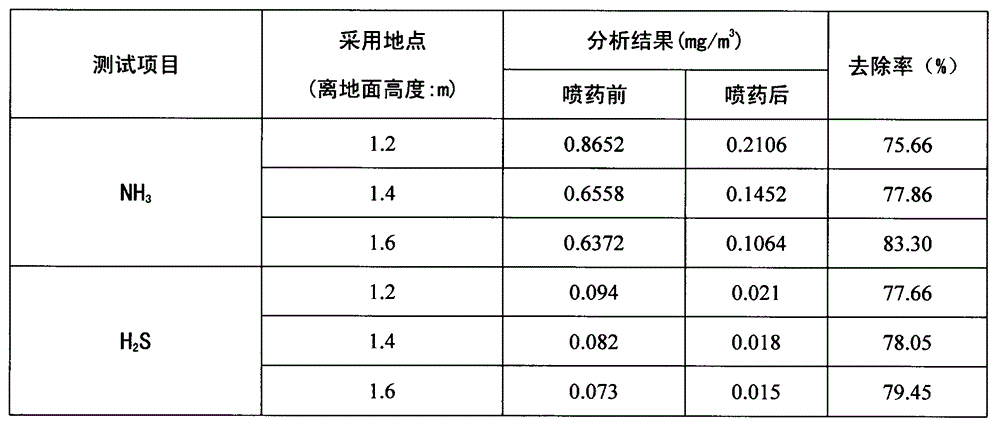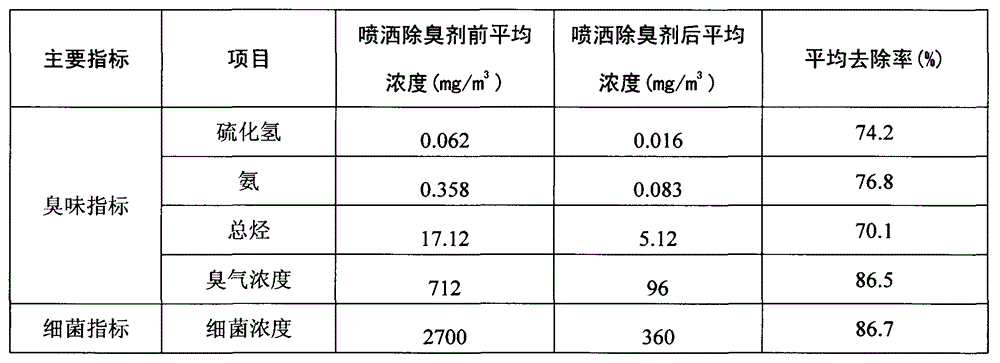Plant-source deodorant for urban garbage disposal
A deodorant, plant-derived technology, applied in plant growth regulators, chemicals for biological control, deodorization, etc., can solve problems such as secondary pollution of the environment, and achieve safe use, significant deodorization effect, and deodorization. odor effect long lasting effect
- Summary
- Abstract
- Description
- Claims
- Application Information
AI Technical Summary
Problems solved by technology
Method used
Image
Examples
Embodiment 1
[0023] Example 1: Toxicity determination of cassia bark extract, clove extract, eucalyptus leaf extract and their mixtures to Aspergillus niger
[0024] After pre-testing to determine the effective inhibitory concentration range of each extract, each extract and its mixture were treated with 5 doses according to the content of active ingredients, and water was used as a control. Refer to the "Pesticide Indoor Bioassay Test Guidelines for Fungicides", and use the mycelium growth rate method to determine the toxicity of the agent to Aspergillus niger. After 72 hours, the colony diameter was measured by the cross method, and the net growth rate of each treatment was calculated for mycelial growth inhibition rate. The formula for calculating the antibacterial rate is as follows:
[0025] Mycelial growth inhibition rate (%)=(control colony diameter-treatment colony diameter) / control colony diameter×100
[0026] The mycelia growth inhibition rate was converted into a probability v...
Embodiment 2
[0035] Example two: 2.5% cinnamon clove eucalyptus leaf extract plant source deodorant is used for deodorization test of municipal solid waste
[0036] Add 1.0% of clove extract, 1.0% of cinnamon extract, 0.5% of eucalyptus leaf extract, 3.0% of polyvinylpyrrolidone, and make up the remaining water to 100%, and mix them evenly at room temperature to form 2.5% of cinnamon, clove, and eucalyptus Deodorant of plant origin with leaf extract.
[0037] The above-mentioned plant-derived deodorant agents were used for the deodorization test of domestic garbage. Monitoring conditions: Put a pile of about 100kg of highly decomposed and odorous garbage (mainly domestic garbage) in a closed room of 10m×6m×3m, and arrange 3 sampling points evenly at about 0.5m around the garbage. The heights of the points from the ground are 1.2m, 1.4m, and 1.6m respectively. Use the deodorant agent mixed with 50 times of water to spray evenly on the surface of the garbage. The surface is completely wette...
Embodiment 3
[0042] Embodiment three: 3.0% cassia bark · clove · eucalyptus leaf extract is used in the field deodorization test of municipal solid waste
[0043] 1.2% clove extract, 0.8% cinnamon extract, 1.0% eucalyptus leaf extract, 2.0% polyvinylpyrrolidone, 2.5% sodium lauryl sulfate, and make up the remaining water to 100%, and mix evenly at room temperature, that is A plant-derived deodorant formulated with 3.0% cinnamon, clove, and eucalyptus extracts.
[0044]The garbage disposal site in Xichong County, Nanchong City, Sichuan Province was selected as a field experiment, and Nanchong City Environmental Sanitation Testing Center was entrusted to test the concentration of odor-related components and the total number of bacteria in the garbage. Before spraying, measure the concentration of relevant components and the total number of bacteria in the garbage odor, and then dilute the prepared deodorant by 50 times, and spray evenly on the surface of the garbage, taking the surface as th...
PUM
 Login to View More
Login to View More Abstract
Description
Claims
Application Information
 Login to View More
Login to View More - R&D
- Intellectual Property
- Life Sciences
- Materials
- Tech Scout
- Unparalleled Data Quality
- Higher Quality Content
- 60% Fewer Hallucinations
Browse by: Latest US Patents, China's latest patents, Technical Efficacy Thesaurus, Application Domain, Technology Topic, Popular Technical Reports.
© 2025 PatSnap. All rights reserved.Legal|Privacy policy|Modern Slavery Act Transparency Statement|Sitemap|About US| Contact US: help@patsnap.com


